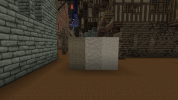Historically the colour of daub has little to do with the welfare of the residents, and more with regional and stylistic preferences, often influenced by the fashion and technology of the time.
For example, in the early middle ages it was uncommon to colour either the daub or timber framing, while in the late middle ages you start to see colours and artworks. In the 16th century people plaster over timber framing to make it appear as a stone building. Later on, in the 19th century, it's suddenly all the rage to limewash the entire structure (timber frame included) and a few decades later they start painting the timber frame black while keeping the daub white, sometimes even adding a tiny bit of ultramarine in the mix to make it appear even whiter.
The natural colour of daub ranges from greyish-white to almost orange-brown, depending on the materials used, the composition and age. There are various reasons to limewash daub (making it white), but the most important one is hygiene; limewash is a base (opposed to acidic) which means it disinfects and kills various organisms you either don't want inside a room or eating your building. A layer of limewash also protects the daub against the weather, decreasing the needed maintenance, and seals the joints between the timber frame and the daub and wattle. It also has cosmetic value, since a white house looks cleaner and limewashing it could hide repairs or changes in the walls.
However you approach it though, you don't see differences in whiteness of daub that differs more than other colours of daub that would warrant a slightly less white daub block over other colour variations. IMO if we start to differentiate between white and slightly less white we also need to add other variations such as grey-brown, brown-yellow, brown-red, dark green, kobalt blue etc. etc..
As with most info I give; it's primarily based on historical building habits in the Netherlands, in this particular case the province of Limburg since that is the only (meaningful) region in the country that had a timber frame and daub and wattle tradition (the rest of the country used wood rather than daub and wattle). The building traditions in France, England, Germany and wherever else could differ quite a lot.
My primary source: Inspectiehandboek Monumentenwacht (sadly not available to the public)










